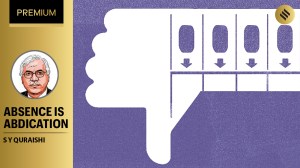Punjab farmers usher in a ‘silent revolution’ by diversifying agriculture through horticulture
Horticulture cultivation records a 42% increase in area and four-fold increase in produce value in a decade
 In 2023-24, the value of horticultural produce recorded a four-fold growth at Rs 26,580.38 crore from Rs 6,267.40 crore in 2011-12, accounting for 17.03 per cent of gross domestic product (GDP) in the agricultural sector. (Express File)
In 2023-24, the value of horticultural produce recorded a four-fold growth at Rs 26,580.38 crore from Rs 6,267.40 crore in 2011-12, accounting for 17.03 per cent of gross domestic product (GDP) in the agricultural sector. (Express File)Punjab farmers backed by the state horticulture department are leading a “silent revolution” in agriculture diversification, recording a 42 per cent increase in the area under horticulture in a decade from 278,583 hectares (6.88 lakh acres) in 2011-12 to 482,000 hectares (11.91 lakh acres) in 2023-24, despite the department operating with “just 25 per cent of its total sanctioned staff strength”.
Emerged as a vital transformation to further diversify the predominantly paddy-wheat cropping system, horticulture occupies only 6.16 per cent of Punjab’s gross cropped area of 7.826 million hectares, yet its economic contribution is remarkable.
In 2023-24, the value of horticultural produce recorded a four-fold growth at Rs 26,580.38 crore from Rs 6,267.40 crore in 2011-12, accounting for 17.03 per cent of gross domestic product (GDP) in the agricultural sector, which stands at Rs 156,068.46 crore, from much less area under cultivation than other traditional crops, according to the horticulture department.
Main horticulture products in Punjab include kinnow, sweet orange, lime, lemon, mango, litchi, guava, pear, peach, plum, grapes, ber, amla, banana, potato, onion, garlic, tomato, brinjal, cauliflower, cabbage, okra, chilli, peas, muskmelon, watermelon, vine crops and root crops, among other — requiring significantly less water compared to paddy and wheat.
Horticultural crops are essential for nutrition security, and with an increasing number of people shifting towards nutritionally rich foods instead of relying solely on grains, their cultivation has assumed significance, giving a fillip to the farmers’ income.
Horticulture growth amid declining gross cropped area
The area under horticulture production in Punjab expanded from 278,583 hectares in 2011-12 to 482,000 hectares in 2023-24 despite a reduction in the state’s gross cropped area — 7.902 million hectares in 2011-12 to 7.826 million hectares in 2023-24.
Notably, the total production of horticultural crops during this period nearly doubled — from5.223 million metric tons in 2011-12 to 9.527 million metric tons in 2023-24.
Moreover, the value of agricultural produce in Punjab doubled over the last decade from Rs 70425.17 in 2011-12 to Rs 1, 56,068.46 crore in 2023-24, while the horticultural produce recorded a four-fold growth of Rs 6,267.40 in 2011–2012 to Rs 26,580.38 crore in 2023-24, underscoring its economic potential for diversification into high-value crops such as fruits and vegetables.
Decadal growth in fruits and vegetables
Fruits and vegetables have been central to Punjab’s diversification efforts, thus, the area under fruit cultivation increased from 76,592 hectares in 2013-14 to 103,287 hectares in 2023-24 and the area under vegetables saw a remarkable rise from 203,734 to 356,476 hectares in the same period.
Additionally, around 20,000 hectares in Punjab are now dedicated to other horticultural crops such as flowers, seeds, mushrooms, medicinal plants, oilseeds, celery and turmeric.
Emphasising Punjab’s immense potential in horticulture, Dr Daljit Singh, Deputy Director of the Horticulture Department, Jalandhar, highlighted the growing trend of farmers, backed by the Indo-Israel Centre of Excellence for Vegetables in Kartarpur, increasing area under pear orchard.
The initiative promotes
polyhouse and walk-in tunnel farming, enabling farmers to grow vegetables of exceptional quality and quantity.
Dr Singh pointed out, “Punjab has advanced technologies for cultivating horticultural crops, which have attracted many small and marginal farmers for assured high returns.”
“Farmers can earn over Rs 1 lakh from a two-kanal plot (one-fourth of an acre) which they are not earning from even one acre by cultivating traditional crops like wheat and paddy,” he noted.
Dr Singh, however, stressed the need for more staff to implement government policies and new techniques effectively. The horticulture department is functioning with only 25 per cent of its sanctioned strength, with nearly 110 Horticulture Development Officer posts lying vacant.
Several farmers share numerous success stories, highlighting the profitability horticulturebrings to them.
A 64-year-old from Sultanpur Lodhi in Kapurthala, Phuman Singh Kaurra says he earns around Rs 2 lakh per acre by growing carrots and seeds. Manjit Singh, a 59-year-old landless farmer (who takes land on rent) from Kotkapura says he earns Rs 4 lakh per acre annually from turmeric cultivation and selling its powder. Bhupinder Singh, a 41-year-old from Rode village in Moga, pegs his earnings from selling garlic seeds at Rs 13-14 lakh per acre. Harbinder Singh Sandhu from Hoshiarpur generates over Rs 1 crore from bell peppers, with a profit of nearly Rs 50 lakh from just six acres.
These farmers are unanimous in promoting diversification into horticultural crops while stating that combined with hard work and regular field monitoring, farming can lead to significant profit. They also stress the importance of government support in processing, marketing and raising awareness about financial assistance schemes for perishable horticultural crops.
Talking about the driving forces behind this horticulture revolution, Punjab HorticultureDepartment Director Shailender Kaur said several factors contributed to this transformation. “The government is promoting several schemes through the state horticulture department like providing subsidies, training, and market linkages to farmers. Farmers are increasingly drawn to horticulture due to its assured high profitability per unit of land compared to traditional crops like wheat and paddy. Horticulture crops often require less water, making them a viable alternative in a state grappling with depleting groundwater levels.”
She believes Punjab’s diversification into horticulture is not just an economic imperative but also an environmental necessity. “With the state’s gross cropped area stagnating, expanding horticulture could provide a sustainable pathway to bolster farmers’ incomes while reducing environmental stress.”
Farmers feel proper cold chain facilities and adequate transportation networks can result in saving huge wastage (nearly 15-20 per cent) of perishable horticultural commodities which is taking place in the absence of proper management systems like processing units, cold chains, expanding cold storage and processing infrastructure. These are essential to minimise losses and maximise profits.












